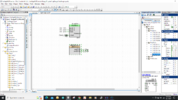Learning barriers are actually getting easier.
Example kids in 6'th grade (and me) are using block programming languages
to do simple to, in some case, complex designs. Kids doing robot stuff. Here is
two examples of using block programming, a sophisticated timer and a talking
voltmeter. Look at the blocks and their flow, and you might be surprised you can
make some sense out of them. The blocks are then converted to code for you, and
the micro programmed.
Then there are devices like PSOC where you can do codeless logic designs. A chip
with various logic elements, that you drag and drop onto canvas, wire up, hit build
button, done. Like having your pile of chips and your breadboard, but inside a chip.
Note a small amount of code gets generated, but for codeless designs you do not
diddle with this.
Here is a simple example using mBlock to turn on something when a V is exceeded -
Read the blocks and the comments, its fairly obvious whats going on.
Now here is a codeless design using just logic elements inside PSOC tool -
This design has a 2 bit counter running at 1 Hz, and it cycles a 1 in 4 out mux, such that
each clock turns on one output to light one LED. No code written by user. Note dashed lines
indicate stuff/wiring is offchip. Note one R was used because only one led on at a time,
otherwise you would use an R for each led.
I could have added a push button, with a debounce block, that would cycle one led to the next
with each button push. Or used the button to start the counter, had it run once, and using a F-F
stopped it after it ran all 4 leds. No real limitation if you have been using discrete logic.
In the library of logic elements the community has added some 74HC components (you can easily
design your own component from scratch). In PSOC lingo a component is an onchip resource.
I recently did a component design, 64 bit Serial In Parallel out shift register to see if I could fit
it in the package (eg. # pins). That's a little more involved but you get the idea.
Notice resource window on right, hardly used any of the parts overall resources. A couple of %.
So in short you can do codeless designs and ease into programming as you go should you
choose to do so.
Board to use mBlock is Arduino Nano or Uno, former a $ 2 - $3 board, for mBlock. The PSOC is
board is a $ 15 kind of board. mBlock is free, tool for PSOC, PSOC Creator, also free.
Jump in with both feet, you will never regret it

Regards, Dana.






